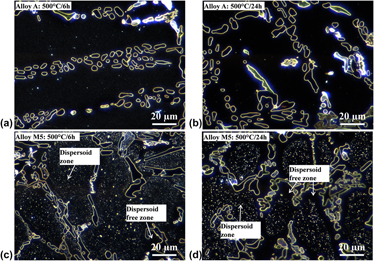Crossref Citations
This article has been cited by the following publications. This list is generated based on data provided by
Crossref.
Yamasaki, Shigeto
Okuhira, Tomo
Mitsuhara, Masatoshi
Nakashima, Hideharu
Kusui, Jun
and
Adachi, Mitsuru
2019.
Effect of Fe Addition on Heat-Resistant Aluminum Alloys Produced by Selective Laser Melting.
Metals,
Vol. 9,
Issue. 4,
p.
468.
XU, Rui
LIN, Bo
LI, Hao-yu
XIAO, Hua-qiang
ZHAO, Yu-liang
and
ZHANG, Wei-wen
2019.
Microstructure evolution and mechanical properties of Al–6.5Cu–0.6Mn–0.5Fe alloys with different Si additions.
Transactions of Nonferrous Metals Society of China,
Vol. 29,
Issue. 8,
p.
1583.
Qian, Xiaoming
Parson, Nick
and
Chen, X.-Grant
2019.
Effects of Mn addition and related Mn-containing dispersoids on the hot deformation behavior of 6082 aluminum alloys.
Materials Science and Engineering: A,
Vol. 764,
Issue. ,
p.
138253.
Lin, Bo
Li, Haoyu
Xu, Rui
Zhao, Yuliang
Xiao, Huaqiang
Tang, Zhengqiang
and
Li, Shaobo
2020.
Thermal exposure of Al-Si-Cu-Mn-Fe alloys and its contribution to high temperature mechanical properties.
Journal of Materials Research and Technology,
Vol. 9,
Issue. 2,
p.
1856.
Li, Haoyu
Lin, Bo
Xu, Rui
Liu, Kun
Xiao, Huaqiang
and
Zhao, Yuliang
2020.
Enhanced mechanical properties of Al–Si–Cu–Mn–Fe alloys at elevated temperatures through grain refinement and dispersoid strengthening.
Materials Science and Technology,
Vol. 36,
Issue. 3,
p.
307.
Lin, Bo
Xia, Songchao
Tang, Yue
Zhao, Yuliang
Liu, Kun
Xiao, Huaqiang
Li, Shaobo
and
Zhang, Weiwen
2020.
Effects of thermal exposure on the microstructure and mechanical properties of Al-12Si-4Cu-1Ni-1Mg-2Mn piston alloys.
International Journal of Cast Metals Research,
Vol. 33,
Issue. 6,
p.
250.
Jin, L.
Liu, K.
and
Chen, X.-G.
2020.
Improved Elevated Temperature Properties in Al-13%Si Piston Alloys by Mo Addition.
Journal of Materials Engineering and Performance,
Vol. 29,
Issue. 1,
p.
126.
Rakhmonov, Jovid
Liu, Kun
Pan, Lei
Breton, Francis
and
Chen, X.-Grant
2020.
Enhanced mechanical properties of high-temperature-resistant Al–Cu cast alloy by microalloying with Mg.
Journal of Alloys and Compounds,
Vol. 827,
Issue. ,
p.
154305.
LIN, Bo
FAN, Tao
LI, Hao-yu
ZHAO, Yu-liang
ZHANG, Wei-wen
and
LIU, Kun
2021.
Microstructure and high temperature tensile properties of Al–Si–Cu–Mn–Fe alloys prepared by semi-solid thixoforming.
Transactions of Nonferrous Metals Society of China,
Vol. 31,
Issue. 8,
p.
2232.
Li, Yong
Wang, Haiyao
Qian, Xiaoming
Wang, Zhaodong
Xu, Guangming
and
Li, Jiadong
2021.
Microstructure and elevated-temperature mechanical properties of dispersoid-strengthened Al-Mg-Si-Mn alloys produced by twin roll casting.
Progress in Natural Science: Materials International,
Vol. 31,
Issue. 5,
p.
705.
Liu, Yanyu
Jia, Lina
Wang, Wenbo
Jin, Zuheng
and
Zhang, Hu
2022.
Effects of Ni content on microstructure and wear behavior of Al–13Si–3Cu–1Mg-xNi-0.6Fe-0.6Mn alloys.
Wear,
Vol. 500-501,
Issue. ,
p.
204365.
Lin, Bo
he, xiangxiang
Zhao, Yuliang
Xu, Rui
and
Lu, Yemao
2022.
Evolution of Iron-Rich Intermetallics and its Effect on the Mechanical Properties of Al-Cu-Mn-Fe-Si Alloys after Thermal Exposure and High-Temperature Tensile Testing.
SSRN Electronic Journal ,
Dudareva, N. Yu.
Gallyamova, R. F.
Deev, V. B.
and
Kolomeichenko, A. V.
2022.
Features of Coating Formation by Micro-Arc Oxidation on High-Silicon Aluminum Alloy.
Journal of Surface Investigation: X-ray, Synchrotron and Neutron Techniques,
Vol. 16,
Issue. 6,
p.
1301.
Xu, ShiWei
Khanlari, Khashayar
Lin, Bo
Fan, Tao
Xia, Songchao
Achouri, Inès Esma
Zhang, Weiwen
and
Jiang, Yun
2023.
Effects of Fe-Addition as a Beneficial Modifying Element on the Microstructure and Mechanical Properties of an Al–Si–Cu–Mg–Ni–Mn Piston Alloy.
Metallography, Microstructure, and Analysis,
Vol. 12,
Issue. 3,
p.
401.
Bo, Lin
Xiangxiang, He
Rui, Xu
Yuliang, Zhao
Yemao, Lu
and
Huaqiang, Xiao
2023.
Evolution of iron-rich intermetallics and its effect on the mechanical properties of Al–Cu–Mn–Fe–Si alloys after thermal exposure and high-temperature tensile testing.
Journal of Materials Research and Technology,
Vol. 23,
Issue. ,
p.
2527.
LIN, Bo
HE, Xiang-xiang
XIA, Song-chao
XIAO, Hua-qiang
ZHAO, Yu-liang
and
KHANLARI, Khashayar
2024.
Effect of ultrasonic and mechanical vibration treatments on evolution of Mn-rich phases and mechanical properties of Al−12Si−4Cu−1Ni−1Mg−2Mn piston alloys.
Transactions of Nonferrous Metals Society of China,
Vol. 34,
Issue. 8,
p.
2393.
Mahton, Yogendra
Jha, Vibhav
and
Saha, Partha
2024.
Effect of Heat Treatment on Microstructure, Mechanical, and Corrosion Properties of Squeeze Cast Al 319.0 Alloy.
International Journal of Metalcasting,
Vol. 18,
Issue. 1,
p.
512.
Xiao, Peijie
Xu, Shiwei
Chen, Longbao
Liu, Yu
Li, Jianyu
Xiao, Zhi
and
Meng, Xianming
2024.
Effect of Casting Process and Thermal Exposure on Microstructure and Mechanical Properties of Al-Si-Cu-Ni Alloy.
Materials,
Vol. 17,
Issue. 18,
p.
4598.
Tan, Yunxiang
Zhao, Haidong
and
Xu, Qingyan
2024.
Numerical simulation of solidified microstructure of ternary Al-Si-Mg alloy using an improved cellular automaton method.
Science China Materials,
Vol. 67,
Issue. 4,
p.
1150.
Wei, Qiuyun
Zhao, Yuliang
Liu, Huan
He, Weixiang
Wang, Mengmeng
and
Sun, Zhenzhong
2024.
Effect of heat treatment on the deformation behavior of an Al–Cu alloy studied by in-situ synchrotron X-ray diffraction.
Materials Science and Engineering: A,
Vol. 914,
Issue. ,
p.
147138.



